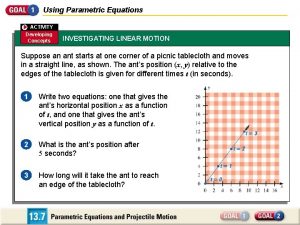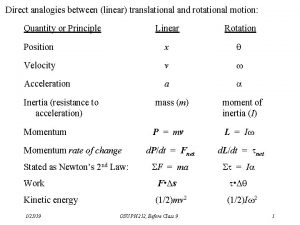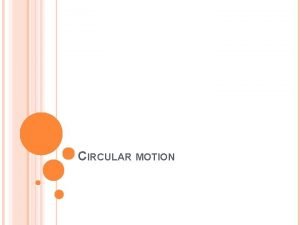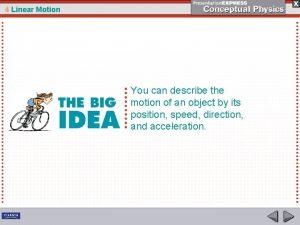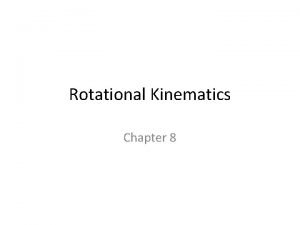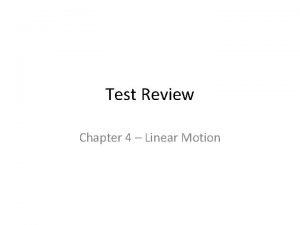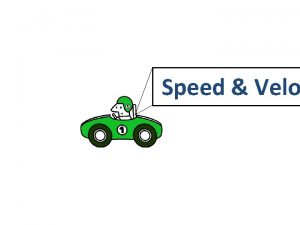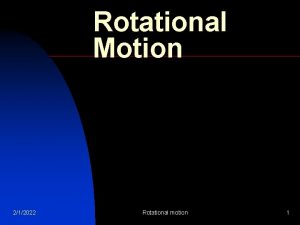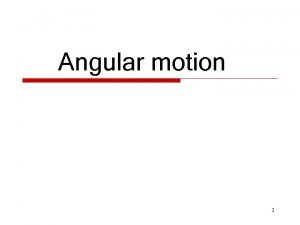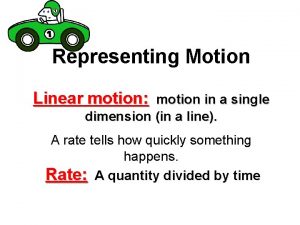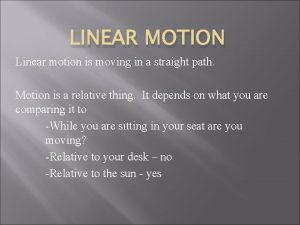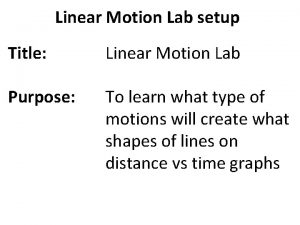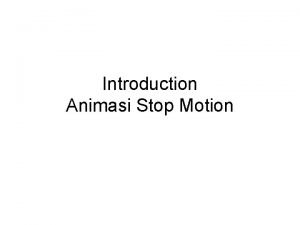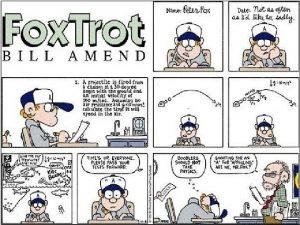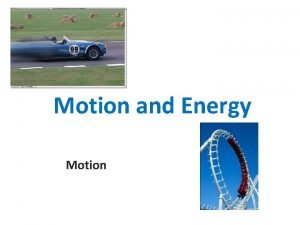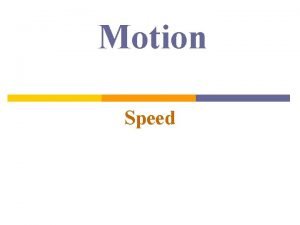Linear Motion 212022 1 Introduction n 212022 An

















- Slides: 17

Linear Motion 2/1/2022 1

Introduction n 2/1/2022 An object’s position is measured from a reference point u Reference Point: A point in our three dimensional universe with x, y and z coordinates. 2

Motion n Motion is a change of position relative to a frame of reference. Frame of reference: A set of x, y and z axes. u Example – a car is moving 30 miles per hour relative to the road u

Frame of Reference n Unless stated otherwise, when we discuss the speeds of things in our environment, we mean speed with respect to the surface of the Earth.

Distance n The length between a reference point and the object being measured or another reference point u. Measured in metric units (base unit = meters)

Time n A one-dimensional quantity used to sequence events, to quantify the durations of events and the intervals between them. u Measured in seconds

Second A second is defined to be the duration of 9, 192, 631, 770 periods of the radiation corresponding to the transition between the two hyperfine levels of the ground state of the cesium 133 atom.

Speed n n To calculate speed, you need to know both distance and time Objects that travel at different speeds move different distances in the same amount of time

Speed Formula n n Speed can be calculated by dividing the distance an object travels by the time it takes to cover the distance The formula for finding speed is Speed = distance/time S=d/t 2/1/2022 9

Standard Units n n n 2/1/2022 The standard units for speed in meters per second or kilometers per hour In the English system speed is measured usually as miles per hour One mile per hour equals. 45 meters per second (m/s) 10

Average Speed n n 2/1/2022 Your instantaneous speed, which is difficult to measure, is your moment-to-moment speed Your average speed is the calculated measure of your speed over a distance (total distance / total time). 11

Developing Graphing Skills n n Speed is measured by the steepness, or, slope, of a line. Slope is defined as the change in y -values divided by the change in xvalues A rising line, or positive slope, indicates that the distance an object travels from its starting point is increasing with time. u A horizontal line, or 0 slope, indicates that the speed is zero meters per second u 2/1/2022 12

Speed Graph n This graph shows constant speed

Velocity n n n 2/1/2022 Velocity is a speed in a specific direction Velocity is an example of a vector A vector is a quantity that has both size and direction 14

Velocity Formula n n Velocity can be calculated by dividing the distance an object travels by the time it takes to cover the distance The formula for finding velocity is Velocity = distance/time v=d/t * Must include a direction in the answer 2/1/2022 15

Acceleration n Acceleration is the change of velocity over time Acceleration is calculated by dividing the change of velocity by the time it takes to change The formula for finding acceleration is Acceleration = velocity/time a = Δv / t * Must include a direction in the answer

Acceleration Cont. a = v f – vi / t n Can be + (Acceleration) n Can be – (Deceleration) 2 n Units are m/s/s or m/s n 2/1/2022 17
 Type of range of motion
Type of range of motion Periodic motion formula
Periodic motion formula An object in motion stays in motion
An object in motion stays in motion Chapter 2 section 1 describing motion answer key
Chapter 2 section 1 describing motion answer key What is acceleration
What is acceleration Motion section 1 describing motion
Motion section 1 describing motion Chapter 1 lesson 2 describing motion answer key
Chapter 1 lesson 2 describing motion answer key Section 1 describing motion
Section 1 describing motion Linear motion equations
Linear motion equations Uniform linear motion examples
Uniform linear motion examples Which part of the lathe machine is called dead centre mcq
Which part of the lathe machine is called dead centre mcq Analogy between linear and rotational motion
Analogy between linear and rotational motion Rotational motion formulas
Rotational motion formulas Free fall motion
Free fall motion Rotational motion equations
Rotational motion equations Urm motion
Urm motion Conceptual physics chapter 3 linear motion
Conceptual physics chapter 3 linear motion Chapter 4 test linear motion answer key
Chapter 4 test linear motion answer key








